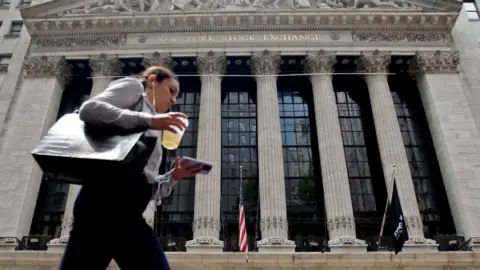The US central bank is poised to lower interest rates for the first time in four years on Wednesday, a milestone moment for the world's largest economy.
The much-anticipated move will influence mortgages, credit card and saving rates for millions of people in the US - and even around the world.
We won't know exactly how big a cut the Federal Reserve will make, or how much lower rates might fall, until the announcement.
So what does this mean for you?
What does a cut mean for mortgages, car loans, and other debt?
The Federal Reserve's key lending rate - what it charges banks to borrow - sets a base for what companies charge people in the US for loans, like mortgages, or other debt, like unpaid credit card balances.
That rate has hovered around 5.3% for more than a year, the highest level since 2001, since jumping from near zero at the start of 2022.
A cut will bring some welcome relief to borrowers, though it will likely mean that some banks knock down the rates they are offering savers too.
Mortgage rates in the US have already dropped a bit, partially in anticipation of the move.
What could the global impact be?

Americans will be most directly affected by a change. But central banks with currencies tied to the dollar often link their rate decisions to the Fed, such as Hong Kong and many Gulf states, so borrowers in those countries will also see an impact.
For the many people outside of the US invested in the US stock market, a cut is also likely good news.
Lower interest rates tend to boost stock prices for two reasons.
First, it means companies can borrow debt for less money and reinvest it to make the business more profitable.
Second, lower rates mean savings accounts and some other kinds of investments become less attractive, so investors tend to move their money towards things like stocks.
Why might the Fed cut rates this time?
Compared to other central banks, the Fed is a bit late to the rate-cutting party.
Europe, the UK, New Zealand, and Canada have cut rates already, and so have many banks in emerging markets.
Those banks all had their own reasons for cutting rates, and how low the Fed decides to go depends a bit on what's pushing it to act.
The Fed raises or cuts rates in response to two factors: inflation and employment.
In 2022, when the Fed started raising interest rates, officials were focused on inflation and wanted to get consumer prices, then rise at the fastest pace since the 1980s, to stabilise.

A jump in rates tends to bring down prices by making it harder to borrow, so people spend less on everything from consumer goods to homes and business equipment.
But less demand also means the economy isn't growing as quickly, and if it slows too much and actually starts contracting then that’s a recession.
In the past, the US economy has often entered recession after a series of rate hikes, costing millions of people their jobs.
And over the last year, unemployment in the US has been ticking higher, as hiring slows sharply.
So is the Fed cutting rates because it has triumphed in its fight against inflation or because the economy is in peril?
Many analysts maintain it's the former. Price inflation hit 2.5% in August.
Officials have said they're increasingly confident inflation is headed back to normal, so their attention is turning to the risks to the job market.
One factor officials have insisted does not inform into their decision is the election.
Republicans and Democrats have been watching this Fed's moves closely for two years, and a cut will likely help Democrats as the party in power.
But Fed chair Jerome Powell has said time and again that the bank is focused on economic data, not politics, in making its move.
How big will this rate cut be?

Analysts are divided about whether the Fed will announce a cut of 0.25 percentage points or go for a bigger, and more unusual, 0.5 percentage points cut.
For a bank that has tried hard to telegraph its moves well in advance, the level of uncertainty is unusually high.
An isolated rate cut, even a bigger one, might not make that much of a difference to regular borrowers.
But this meeting is expected to mark the start of a series of actions that will bring borrowing costs lower over the next year or so.
Just how low remains a matter of debate.
Mr Powell will presumably be asked about it at the press conference after the bank's announcement, and he will presumably say it will depend on the data - his go-to response.
But the Fed will release a chart showing what its members predict, which could help shape that picture.
Latest Stories
-
T-bills: Government’s target fell short by GH¢58.11m; interest rates surged
2 seconds -
‘Ghana’s education sector is in crisis’ – President-Elect Mahama calls for national forum
6 minutes -
Ghanaian movies released in 2024
12 minutes -
Another deadly crush in Nigeria at event offering free food
19 minutes -
Cyclone Chido kills 94 people in Mozambique
27 minutes -
How tactless NDC exonerated the Electoral Commission
44 minutes -
Tiger Woods’ son Charlie, 15, hits first hole-in-one
51 minutes -
‘¢25m is just a drop in the ocean’ – WAEC on delayed results
56 minutes -
NPP’s Central Regional Chair, Robert Kutin dead
1 hour -
Global Football Festival promises football museum and music experience on December 27
1 hour -
Saudi warnings about market attack suspect were ignored
1 hour -
Trump threatens to try to regain control of Panama Canal
1 hour -
Court orders police to determine gender of accused
1 hour -
Ghana’s gold production to rise marginally by 3% in 2025 – Deloitte
1 hour -
A man’s suicide leads to clamour around India’s dowry law
1 hour

